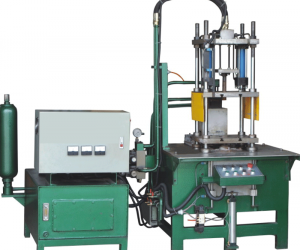Share-alt
Facebook
Twitter
Youtube
Pinterest
Linkedin
Know Die Casting in One Minutes
The Process of Die Casting
The liquid or semi-liquid metal or alloy is poured into the pressure chamber of the die casting machine, which makes the pressure chamber fully filled in the high pressure and high speed, so that it forms and crystallizes under high pressure to obtain castings.

The Kinds of Die Casting
It’s very difficult to use usual die casting technique, because if the inner air with the machine is not totally empty, the item will appear bubbles in some parts. Especially if the parts are used in the joint. As for the gravity casting technique, it produces high quality items with high density.
1) Gravity casting
2) Usual die casting
3) Cold chamber die casting
4) Hot chamber die casting

the cold chamber die casting technique is always in the Aluminum, and the Zinc is usually in hot chamber die casting technique, because the Aluminum temperature is higher than the Zinc, the process is more complicate with the Zinc
The Importance of Process
High pressure and high speed are just the two characteristics of the liquid metal filling and forming process in die casting, and they are also the difference between die casting and other casting methods.
If these can not be got, the parts will not be the sample that you want, it will be as the same as the die casting slag bag
Once everything goes well, the castings need to be polished to keep the nice appearance, such as the aluminum castings. After polishing, the castings are very beautiful and delicate.
The Unfavorable Condition of the Process

High Temperature
1) Air bubbles are formed by massive air. Because the high-speed alloy liquid flow may block the exhaust system, so that the cavity is surrounded by the air, and the rapidly cooling liquid may prevent the dissolved gas in the melt from being effectively precipitated;
2) The alloy liquid flows into the cavity in a spray form and adheres to the mold place, and the alloy liquid that enters later cannot be fused with it, resulting in surfacial defects and reducing the surfacial quality of the casting;
3) The vortex is generated, which encloses the air and the cold alloy that first enters the cavity, causing the casting to have defects of pores and oxidation inclusions;
4) The wall of the die-casting model is washed to accelerate the wear of the die-casting die and reduce the life of the die-casting life span
The Defects of Die Casting
1) Surficial defects: flow marks, patterns, reticulated fins, cold insulation, shrinkage, imprints, iron beans, mechanical strains, mold strains and bumps, etc.
2) Inner defects: stomata, bubbles, shrinkage porosity
3) Geometric shape does not match the pattern: under-casting and unclear outline, deformation, fins, fleshy or fleshy, wrong edge or wrong button, misaligned core
4) Material properties do not meet requirements: chemical composition and mechanical properties do not meet the requirements; impurity defects refer to slag inclusions and hard spots
Share-alt
Facebook
Twitter
Youtube
Pinterest
Linkedin
Previous Post
Next Post